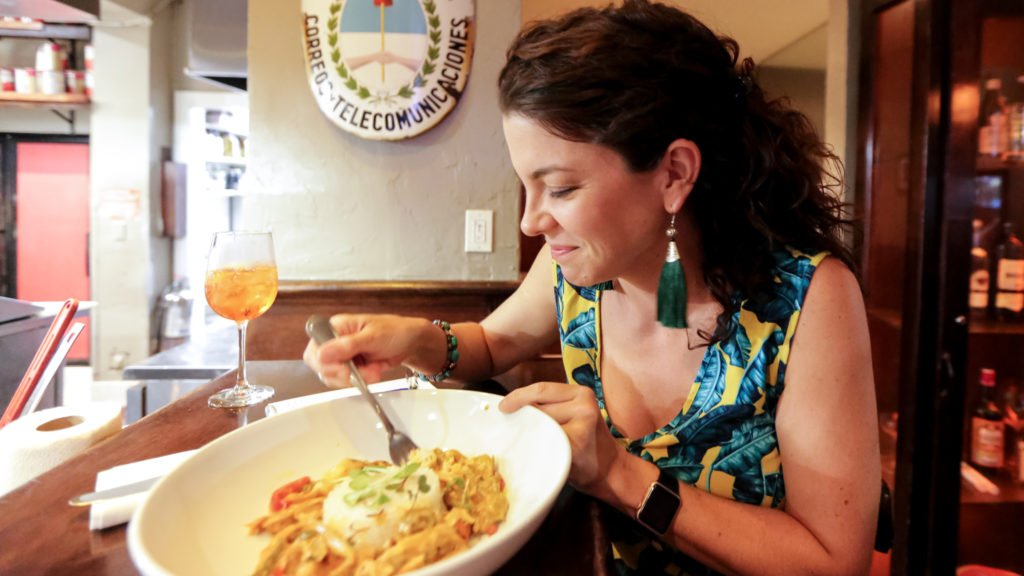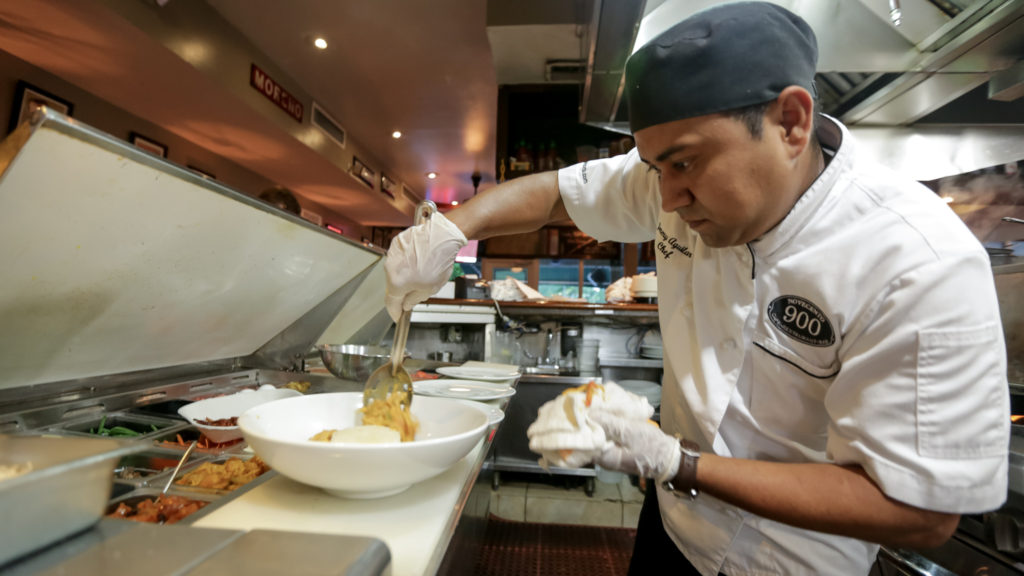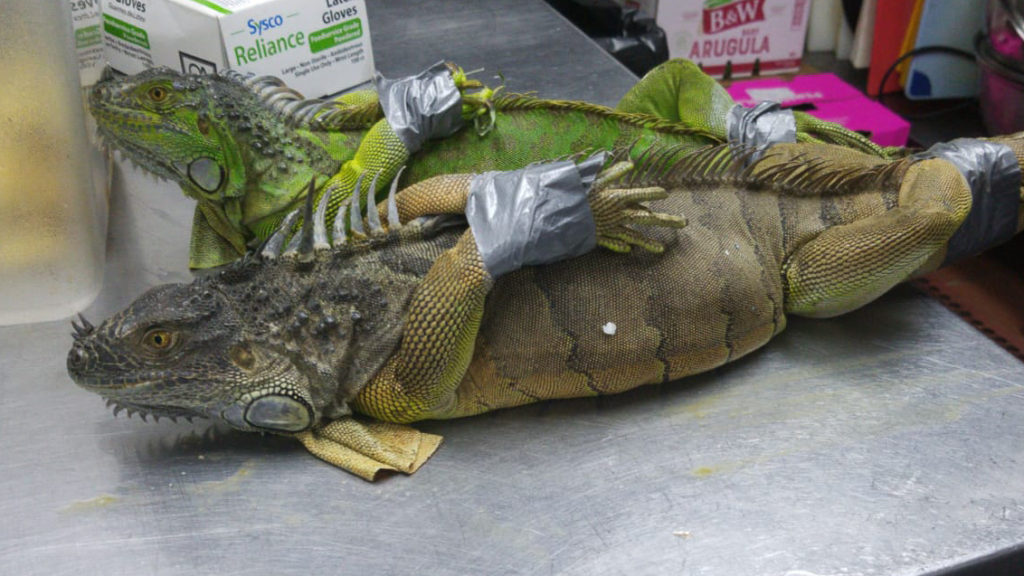Taste of the Iguana: A Savory Solution to Invasive Reptiles
Annali HaywardJuly 29, 2019

Key News reporter Annali Hayward samples an iguana recipe at Novecento, July 15, 2019. Iguana is eaten as a delicacy in many nations and is starting to be available in the U.S. (Key News/Tony Winton)
For some, iguanas are an exotic-looking nuisance that, at the benign end of the scale, frighten kids and poop in your pool. But for others – including the Florida Wildlife Commission – their burrowing through seawalls, decimating native plants and downing power lines is no joke.
The FWC encourages residents to kill the critters (humanely) wherever possible.
But for some, eating the problem is a viable solution, coming with growing interest in harvesting iguanas for food rather than just disposing of them.
Local institution Novecento was up for the challenge. Could they make the beasties taste as good as the rest of their menu?

Chef Jimmy Aguilar spoons out a portion of curried igauana over rice, July 15, 2019. Key News invited him to come up with a creative recipe for Iguana, which is served in many nations. (Key News/Tony Winton)
I was in the capable hands of chef Jimmy Aguilar, who readily admitted it was his first time cooking iguana, despite its popularity in his native Nicaragua. Aguilar had got his hands on two big specimens, caught wild by a provider up near Tampa. I was glad – far more interesting than ordering obscure meat, pre-packaged from an online supplier. Provenance is key.
Even better, Aguilar had curried it. I think a bit of spice is in order for something this exotic – and this kind of preparation should give the meat a chance to really macerate with complementary flavors.
OK, so let’s get the ethical-treatment-of-animals bit out of the way. I am not exclusively carnivorous; I’m happily veggie three times a week. I just happen to have eaten a lot of weird things in a lot of different places. Frogs legs in Shanghai. Jellyfish in Hong Kong. Something with bits of snake in it in Vietnam. Ostrich steaks from Borough Market in London. Blood sausage.
I think a meal’s a meal – it only matters whether it tastes good. And in fact, I feel less sorry for our little free-roaming, pool-dipping friends than I do for a caged chicken. We are just used to eating one and not the other.
“In Nicaragua it is expensive because it is rare and many people want it,” affirmed Aguilar.
With that, I dug in. Just as expected – it tastes like chicken. Gamey, wild, slightly tougher chicken. In fact, if I hadn’t been told, I might have assumed it was chicken – apart from the size of the morsels, which gives it away somewhat.
Together with fellow cook Martin Alcerro, who is from Mexico, Aguilar had simmered the meat for over an hour before adding it to the curry of onions, garlic, potato, red and yellow bell peppers, spices, and coconut milk to finish off. Over simple rice with a few perfect platano tostones, it was a delicious plate that, to my mind, would absolutely have a home on any South Florida menu. Yes, OK, I wanted a bit more heat from the spices, but I appreciated Aguilar’s gentle touch, and – most importantly – the texture and flavor he got from the meat.
So will we see it on the menu? Aguilar wasn’t sure. “It depends if it tastes good and what the reaction is!”
Therein lies the (spice) rub. Will customers accept establishments who try it out on their menus – let alone order it? I’m not sure the mass market is ready. But there could be a tipping point in the not-too-distant future.
“If we can alter the culture, we should,” said Ron Magill, wildlife expert and communications director at Zoo Miami.
“It’s like what’s being done with lionfish,” Magill continued, citing the famous example of a non-native invasive species that has increasingly found itself on Floridian dinner plates.
But to get there, commercial kitchens would need to upskill. Unlike in Central America and the Caribbean, Aguilar and his chefs are not used to preparing iguana, so by his estimate it took the team around two hours longer to prepare than a chicken – something he says would improve with practice.
Magill said regulated commercialization would be preferable to wholesale slaughter by the public, taking issue with the FWC’s exhortation for the public to kill iguanas as meat.

In this image provided by Novecento restaurant, iguanas sit on a kitchen work table, July 15, 2019 (Novecento/Jimmy Aguilar via Key News)
Magill is ready to answer his critics. “I have led my life in conservation, to protect wildlife. These iguanas have not been a well-managed population. I’ve gotten pushback. But we have a responsibility to manage our natural environment.”
Green iguanas first appeared in the 1960s in Hialeah, reportedly released by private owners. Since then, their numbers have grown exponentially.
“I’ve heard between tens of thousands to millions,” said Magill. It’s hard to say how many are on Key Biscayne but “they are getting more savvy – I am sure they go after the seawalls and compromise them,” he continued. “They are destructive to the economy.”



Responses
Jackie Kellogg
Jul 29
Something about that photo…makes me think of ICE. I would eat the meat if it were sold butchered and wrapped up-like chicken. I am hoping for iguana birth control!
The comments are closed.